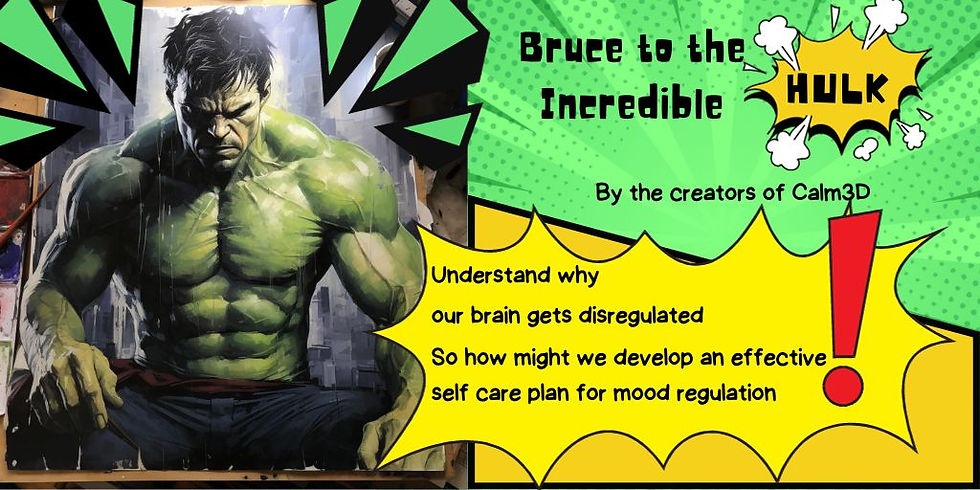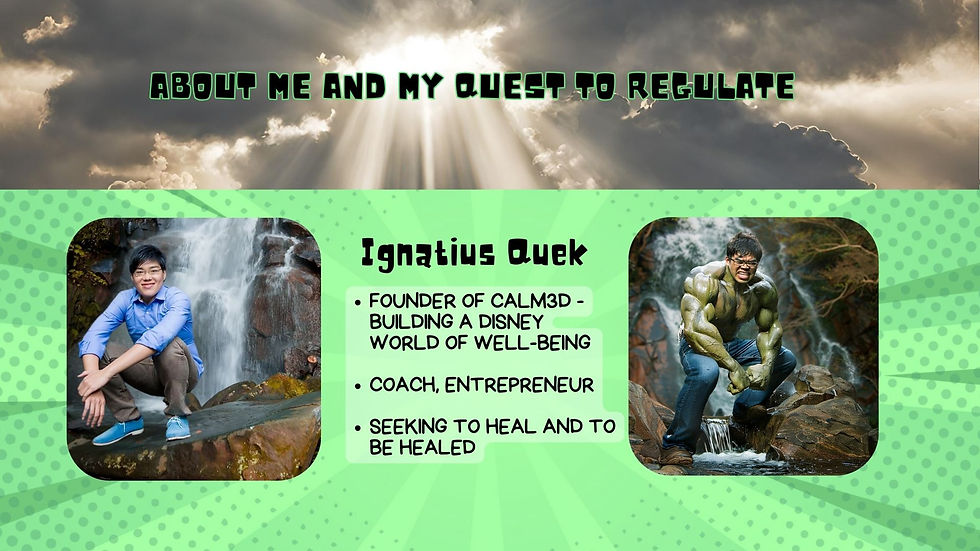Anger Management Singapore: Anger Management is Personal Needs Management!
- Ignatius Quek

- Feb 6
- 4 min read
How do I effectively manage my anger?
I feel out of control, how can I manage my anger better? I've read all the resources online about mindfulness, being aware of my body responses and learning when to step out and calm down.
However I am still dysregulated and my anger affects the ones I love!
Key Message of Hope:
Anger doesn’t define you. It’s simply a signal that something important is missing in your life. By understanding and addressing your unmet needs, you can shift from being “an angry person” to someone who is capable, calm, and in control of their emotional well-being.
TL;DR of Anger Management Singapore: Anger Management is Personal Needs Management!
Anger is not the problem—it’s a reaction to unmet needs. By identifying and addressing these needs, you can reduce anger and create a life where calm, joy, and fulfillment become your default state, rather than frustration.
Let's change our identity of one who is constantly angry, to one who is angry on specific situations.
Understanding Anger: A Reaction to Unmet Needs
Many people believe they have an “anger problem,” but what if anger itself isn’t the issue? What if anger is simply a signal—a reaction to something deeper?
The truth is, anger often stems from unmet personal needs. Whether it’s a need for respect, autonomy, recognition, or emotional safety, when these needs go unfulfilled, frustration builds up—often leading to outbursts, resentment, or emotional shutdowns.

Common Signs That Anger is Rooted in Unmet Needs:
✔️ You feel unheard or disrespected in relationships or at work.
✔️ You often feel out of control when anger arises.
✔️ You suppress anger until it explodes in unexpected ways.
✔️ You believe anger is just "who you are."
But the good news is, anger doesn’t have to control you. By managing your personal needs effectively, you can create a life where anger is no longer your default response—it becomes the exception, not the rule.
Anger is usually about justice and a common theme is the need for fairness. It also relates to need for belonging, acknowledgement, expression, safety, recognition. If important needs are not met, you feel a sense of injustice and the anger informs you.
I know this because this is how I am wired! I created www.playcalm3d.com just so that I and people like me can use it. It is my quest and life purpose to promote anger management in Singapore through therapy or coaching and. to provide tools to help individuals feel regulated when necessary.

Step 1: Recognizing Your Needs
Before managing anger, you need to identify what it’s trying to tell you. Ask yourself:
🔹 What do I truly need in this moment? (Respect, security, validation, connection?)
🔹 Is this need within my control, or is it an external factor?
🔹 How do I usually respond when this need isn’t met?
Example: If you often feel frustrated at work, is it because you’re being overworked without recognition? Your true need might be appreciation or fair treatment. Instead of reacting with anger, you can explore ways to communicate or create change.
Internal vs. External Needs
Identify who can meet your needs helps you build a boundary and draw your locus of control.
You can only control the needs you can meet on your own, or have a high predictability of getting someone else meet your need.
🔹 Internal Needs: Rest, self-care, self-acceptance → You can control how you meet them.
🔹 External Needs: Respect, recognition, fairness → You can request them, but not always control them.
Understanding this distinction helps you develop healthy strategies instead of reacting impulsively.
Step 2: Learning Strategies to Meet Your Needs
Once you’ve identified your needs, the next step is learning how to fulfill them in a balanced way.
1. Self-Sufficiency: Can You Meet This Need Yourself?
Instead of waiting for others to meet your needs, ask:✔️ Can I create personal routines for self-care and emotional regulation?✔️ Can I adjust my mindset to reduce dependency on external validation?
Example: If your need is relaxation, don’t wait for a vacation—schedule micro-breaks in your daily routine.
2. Building a Healthy Support System
Not all needs can be met alone. Identify people who can help fulfill your emotional needs in a healthy way.
✔️ Practice assertive communication to express what you need.
✔️ Set boundaries with people who trigger your anger.
✔️ Surround yourself with supportive relationships.
Example: If your need is emotional support, find friends or professionals who provide a safe space for open conversations.
Reminder, it may also not be the right time and place for doing this now. Set aside some planning time to consider what would be the best way to go about this, or an emotions coach can help!
Step 3: Reframing Your Identity – You Are Not “An Angry Person”
The most powerful transformation happens when you change how you see yourself.
🚫 Old Identity: “I am an angry person.”
✅ New Identity: “I am someone who recognizes and meets my needs.”
When your core needs are fulfilled, your natural emotional state shifts from frustration to calm, joy, relaxation, and confidence. Anger no longer controls you—it becomes an occasional response to specific situations, not a defining trait.
The Key Reframe:
Anger is an emotion, not an identity. You are not "an angry person"—you are a person learning how to manage your needs and emotions in a healthy way.
Conclusion: Anger is the Exception, Not the Norm
When you shift your focus from “stopping anger” to “meeting your needs”, you regain control over your emotions. You become a person who is generally calm, joyful, relaxed, and fulfilled—with anger showing up only when truly necessary.
Take the First Step Toward Change
If anger has been a dominant emotion in your life, it’s time for a new approach. Instead of fighting anger, learn how to manage your needs effectively.
📞 Ready to regain control? Book a consultation today and start your journey toward emotional balance and fulfillment.




Comments